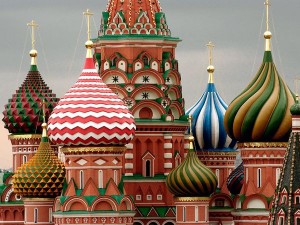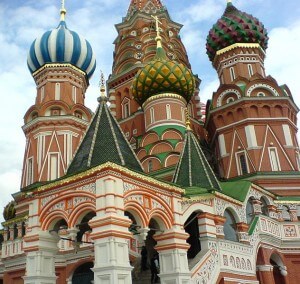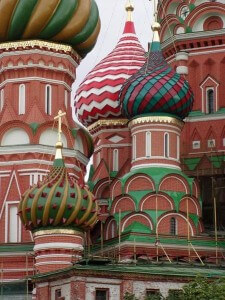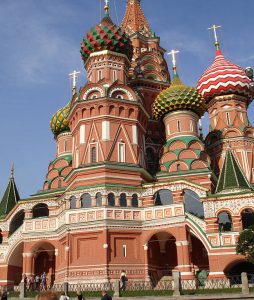The Roof Construction of St. Basil’s Cathedral
Posted on Friday, June 29th, 2012 at 2:21 am

St. Basil’s Cathedral was constructed in 16th century Russia during the reign of Tsar Ivan IV. The cathedral commemorates a military victory against Mongol forces, in which Kazan was captured by the Russians. The layout of the cathedral consists of a central church surrounded by eight smaller chapels. Each of the chapels is associated with an important day during the battle for Kazan. In addition, the cathedral was designed to resemble an eight-pointed star, with each tower on one of eight compass points. It has been speculated that this is an allusion to three eight-pointed stars that decorate the veil of the Virgin Mary in early iconographic images. The number eight has added religious significance, often associated with the eighth day of creation. At a later date, a ninth chapel was added over the tomb of St. Basil.
Architectural Style
The architectural design of the church is unique without any known predecessors. Its influences may include Byzantine, Muslim and possibly, Italian Renaissance architectural styles. It incorporates many East meets West elements.
Domes and Spires

The cathedral has four octagonal towers and four square towers, all built with red brick, an innovation at the time. The towers themselves are richly and elaborately decorated; however, the main focal point is the roof of the cathedral with its colorful, vibrant domes and spires. Each of the towers, as well as the central church, is capped with an onion dome, thought to evoke in its imagery the curving flame of a candle. The central church also features a lofty tented roof, which was a popular roofing style for churches in 16th century Russia.
Construction

Originally, the cathedral was painted white, and the domes were made of tin covered by a layer of fine gold leaf or powder. In the 1670s, the church was revamped, and the gilded domes were replaced with the present-day multicolored domes. Providing structure and support to the inside of the domes was a wooden or metal framework resembling a birdcage. During construction, this framework was built first to give the dome its basic shape. A temporary center pole also may have been used for support. Then the dome was covered with sheets of colorful metal.
The metal pieces were of various sizes that were bent and shaped to create interesting patterns on the dome. The pieces were then riveted together. There were hundreds of different pieces that fit together, some overlapping others, some rounded, some coming out at sharp angles, some bent to form ridges. The onion domes were placed on cylindrical drums which formed the top part of the towers. Finally, rising from the top of each dome was a golden cupola and cross.

Categories: Roof Protection, Roof Replacement, Roofer Qualifications, Roofing Materials
Tags: Austin, Dallas, Denver, Houston, San Antonio
Areas of Expertise
Get Your
Roofing Estimate Now!
TESTIMONIALS
Kidd Roofing San Antonio (Jeremy) responded quickly to our request for an assessment/quote, was friendly and candid, gave helpful advice on dealing with inspectors and insurance, did great work, charged a fair price, and provided excellent documentation we requested. Most impressive was that out of the nearly dozen roofers I contacted, Kidd was the only one who didn’t try to twist our arm into a full roof replacement or stop responding when they realized we just needed minor repairs.
Brityn Willis Bennet
Highly recommended Jeff at Kidd Roofing. I am a real estate who was in a huge bind with a home under contract that needed to have a new roof installed before closing. After dealing with a rough experience with Ace Roofing increasing their quote by 50% for the same job, my clients (very upset at the time) and I scrambled to problem solve and luckily found Jeff and Kidd Roofing.
They got to the job fast, worked our extremely pressed timeline, and had great communication the entire time. To top it off the future buyer of the home had the new roof inspected and the inspector/other roofing company complimented the work. All parties were completely satisfied and I will be recommending and hopefully using Jeff going forward for my future clients.
5 stars well deserved.
CG
We had a leak in a clay tile roof. Mundo and his crew came out and fixed it in one day! They also extended our gutters to help keep water off the foundation. We were thrilled with the service and results.
Micheal H
Kidd Roofing was a pleasure to work with from the start of the job until completion. I highly recommend them.
James O
I love finding a company that values offering and delivering a high quality & affordable service and are honest about the entire process. Kidd Roofing and Cody are my “go to” company and guy for any roofing issues that might arise. I contacted Kidd Roofing about some problems that we were having our add-on cover/roof over the deck a family friend built for us. The particular roofing my husband wanted was unfamiliar to our friend and he did the best he could, the deck is spectacularly amazing but we needed some professional help with the roofing. Cody showed up, on time & prepared, to help us figure out what to do and how to fix it. Cody answered all our questions and explained what needed to be done in a manner that made us reassured to do business with Kidd Roofing. The quote was affordable and we asked to get it done right away. Cody scheduled the work & just like clockwork the roofing crew appeared with the materials and ladders to fix our deck roof. The guys worked fast, cleaned up their leftover material, and were done so fast! Cody even showed up to make sure we were satisfied! Satisfied is an understatement, we were pleasantly impressed and the roof not only looks like our home builder did it when the house was built but we are no longer worried about leaks.
Shannon C
Cody with Kidd roofing did excellent work on our very big project of tearing off and re-roofing a 41 unit condominium complex of 10 buildings. Cody was always available to communicate with and supervise the work as it went along. Everything agreed to on the contract was completed as specified and more. Cody even came back a few weeks after completion to check for hail damage after a big storm. This is a solid, honest company that we will use again.
Cynthia A
Awesome service!!!! We discovered hail damage so, working with my insurance, Kidd Roofing came right out. We were in the middle of a pandemic but they were speedy, safe, repaired the roof in one day and wall damage a different day. We found them professional, honest, speedy, thorough and kind. Totally recommend them!!!
Kim H
Kidd Roofing did a complete re-roof of my house and they did a great job. Every step of the process from the initial visit with me to evaluate the problem to the actual final installation was professionally and efficiently done to my satisfaction.
Enrique B
I had hail damange and a section with leaks. The team that came out made sure that the areas on my roof that was prone to problems because of the house design would not leak. They also included extras that improve the aesthetics as compared to the original roof. The crew paid attention to the details and had excellent workmanship. Finally, at all times, the crew was considerate, friendly and professional.
Annemarie Vicere
I had the unfortunate incident of a tree falling on my house causing over $65k in damages recently and was blessed to find the best roofing company that the Houston area offers…. Kidd Roofing! When I was soliciting quotes the President of Kidd Roofing, Marcus Mathews, not only spent time thoroughly looking over my damages, but stayed until dark to properly tarp my roof since we were expecting rain the next day. He also stressed that it didn’t mean I had to use his company for the repairs, he just couldn’t let me go a night without being properly tarped! Fast forward to the repair job itself and the Sales & Estimating Manager who oversaw my project, Jeff Marshall, was absolutely fantastic. He kept me apprised of all repairs, time frames and completions, he respected my schedule and accommodated me at every turn. He handled everything and was on site a majority of the time to monitor the work that was being performed. The entire process was seamless and they provided high quality results in a short time-frame, even going above and beyond at times. It was the best experience I have had with a company/repair project and I would highly recommend them for any of your roofing repair needs!
Jodi Bieniek
My roof took a direct hit from the April 18th hail storm in Humble, Texas so I searched and asked around my neighborhood and kept hearing Kidd Roofing. After meeting Mike at our house for a quick inspection I knew that Kidd Roofing was the right choice for us. Mike has been amazing throughout the entire process start to finish. He always made sure we knew what the next step was from the insurance side to the day the roofers showed up. Everything that Mike had told us was going to happen happened exactly as he said it would during the roof removal and replace. Mike went above and beyond to set the right expectations and ensure the expectations were met perfectly. Our new roof is almost a month old and can already tell the quality when compared to other roofs that were replaced at the same time. Mike and Kidd Roofing will always be the only roofer I recommend to friends and neighbors. Thank you Mike for a great quality install!
Travis Steele
We had some hail damage to our roof when the last storm came through and got the recommendation of Kidd Roofing from a friend. They sent out Micah Loyd to give us an estimate. He was very professional and easy to work with. He answered all of our questions and was always prompt returning any phone calls or messages we left for him. The roof replacement went on without any problems and looks great. We are happy to recommend Kidd Roofing and Micah for any roofing problems you may have. Five star job!!!!!!
Joan Bone
The entire process from start to finish was excellent and professional. There was an initial meeting with Steve Jasik, Kidd sales and estimating rep, who went over the entire job including materials to be installed, the schedule of the roofers, and steps to close the job when it was finished. When the job began, it all ran like clockwork, from the arrival of the materials; to getting it all up on the roof; to the removal of the old shingles, et al; to the reinstalling of the new shingles; to the clean up afterwards (no roofing nails found anywhere); to the final paperwork to conclude the job. It was all well-handled. We wouldn’t hesitate to recommend Kidd Roofing to anyone who asked.
Steve Richards
Eric Roeslers’ professionalism, product knowledge, and highly competitive price convinced me into choosing Kidd Roofing. The crew was polite, clean, and fast working. There were a few minor details on the roofing of the upper deck of my porch/patio that needed redone and Eric had his crew repair it to my liking. I am very satisfied with his work and will definitely recommend him and repeat business!
Paula G
In the process of getting our house ready to list, we approached Kidd Roofing to give us a quote for a roof replacement. They worked with us on the best way to get our roof replaced including assisting us immensely with us being able to receive a new roof because of previous hail damage. Unfortunately the insurance adjuster didn’t work with us, but Kidd Roofing did all that they could to get us the most value for our money. Now our roof and chimney are brand new and we couldn’t be any happier! I would hire them again in a heartbeat to do any roof work I could ever need in the future!
Jessica Willms
We used Kidd Roofing to repair our leaking roof and they discovered we also had rotted wood fascia behind our gutters due to improperly installed gutters. So they also removed our existing gutters and repaired all of the wood that was rotted for us. They did an outstanding job including several inspections by the Kidd team leaders (Steven Jasik) to ensure everything was done right. We are now big fans of Kidd Roofing. They’re very professional, honest, and easy to work with.
Jerry Beverly
Scott and his crew are the best. He managed the entire process with special attention to every detail. They supported me with all documentation related to the claim. He was with me when the insurance team came by to check the damages, worked with insurance to address any required adjustments and complete the work with precision and super high quality. Next time we need a roofing company, we will definitely reach out to Scott and Kidd.
Fabiano Colicchio Lopes
This is a wonderful company full of wonderful people. They do good, hard work and they are always fair. You can’t find a better company to do your roof! Mason and Todd are very respectful and work with you to provide you with the best service as well as the best customer service. They are diligent and quick! Great job guys 👍🏻.
Eloise Haynes
I acquired quotes from several roofing companies including the one I had last used, just 3-4 years earlier. I most appreciated how my sales rep, Scott, took time to listen and answer my questions. Not in a canned response fashion, but with genuine interest. Looking at their website, I kinda felt I might be considered a lower end customer for them (my house is about $375k), but in no way was I ever treated as such. We have 3 kiddos and the crew did a great job cleaning up after, ensuring no nails or debris could injure our animals or kiddos. They weren’t the cheapest. They also weren’t the most expensive. But I went with Kidd roofing because I felt they did things right, the first time, with quality and excellence. Now that the job is complete — I can confirm, it was all done with quality and excellence. Scott and Kidd roofing are the surest way to have great work done on your roof!
Chris M
I’m someone difficult to please as I like things done right and there are so many roofers that do sloppy jobs. Super happy with Kidd Roofing, worked with me from the start to finish as changes needed to be made. Also did an excellent job cleaning up and I still haven’t found any nails in my yard… I believe they found them all 🙂
Jesse Lowe
Kidd Roofing replaced my 24 year old roof and did a spectacular job. They were very responsive in answering all of my questions as I was a first time roof purchaser. The results were high quality, and they provided options for how to solve my gutter replacement as well as alternatives to managing to keep wildlife out of my attic. Raccoons are cute but very tenacious. I even asked for them to come repair the chimney cap the was knocked off during a storm by an overgrown large tree and they graciously did that for me at no cost. I would highly recommend Kidd Roofing. Max was my contact through the whole process, it was nice to have one single contact that knows your project inside and out. So many times in doing house repairs, I have had to deal with several people from the same company, repeating requirements and reaffirming quotes. That didn’t happen at Kidd, excellent customer service.
K island
We had an awesome experience with Kidd Roofing!!! Davis and his whole team were excellent. We had hail damage and they worked with our insurance company and came right out safely (in the midst of this pandemic). It was done so quickly (finished in a day for the roof and a different day for our wall). They are professional, speedy, honest and super nice. I highly recommend!!
Kim Hiles
This is the third time I have used Kidd Roofing and I continue to great great service and value. The first was a complete new roof. Since then I have called them twice for minor repairs/fixes. They are very responsive and do quality work. They are my roofer and I highly recommend them to others!
Pete Courtois
Because I have solar collectors that needed to be removed before the roof was replaced, I asked Matt to coordinate with the solar people to schedule the replacement. He made all the calls and had his crew here the very next day after the solar collectors had been removed. His crew worked over 12 hours, hardly stopping, trying to finish in one day. They were even cleaning after dark. The very next day he had the gutter crew in early to complete the gutters and finalize the cleanup. Both crews were dedicated and worked very fast to get the job done before any rain. The coordination between crews and other companies was the tops. I can’t say enough about the management and the individuals. This is my second experience with them and both times they were superb.
Lloyd Stearn
We loved our experience with Kidd Roofing. They are very professional and have great communication. I would definitely recommend them to anyone who is looking for great quality and hard workmanship. Jeff and Micah were very present during our roofing experience. They checked in every day and made sure that things were being done and that we were happy with the progress. My husband kept saying you get what you pay for and we did. No more leaks and a beautiful roof.
Jodi Mcallister
Trial
I had an awesome experience with Kidd. The job turned out to cost way less than I expected which of course is always nice. Max was my rep and he came up with a lot of great ideas for a flat-ish portion of my roof which has caused some problems in the past. I met the owner family too and they are solid folks that care about their results. Oh and when they left, the place was spotless.
Michael D. Spadaccini
I have had roofs replaced in the past which did not go well. Kidd Roofing was amazing to work with at every angle, from the top all the way down to the guys that actually did the work. The guys were so friendly and respectful. They were also diligent and clean in every aspect of the job. First rate in quality and professionalism. I give them 5 Gold Stars and a Thumbs Up! Thank you Patrick Lambert and Scott Nelson!
